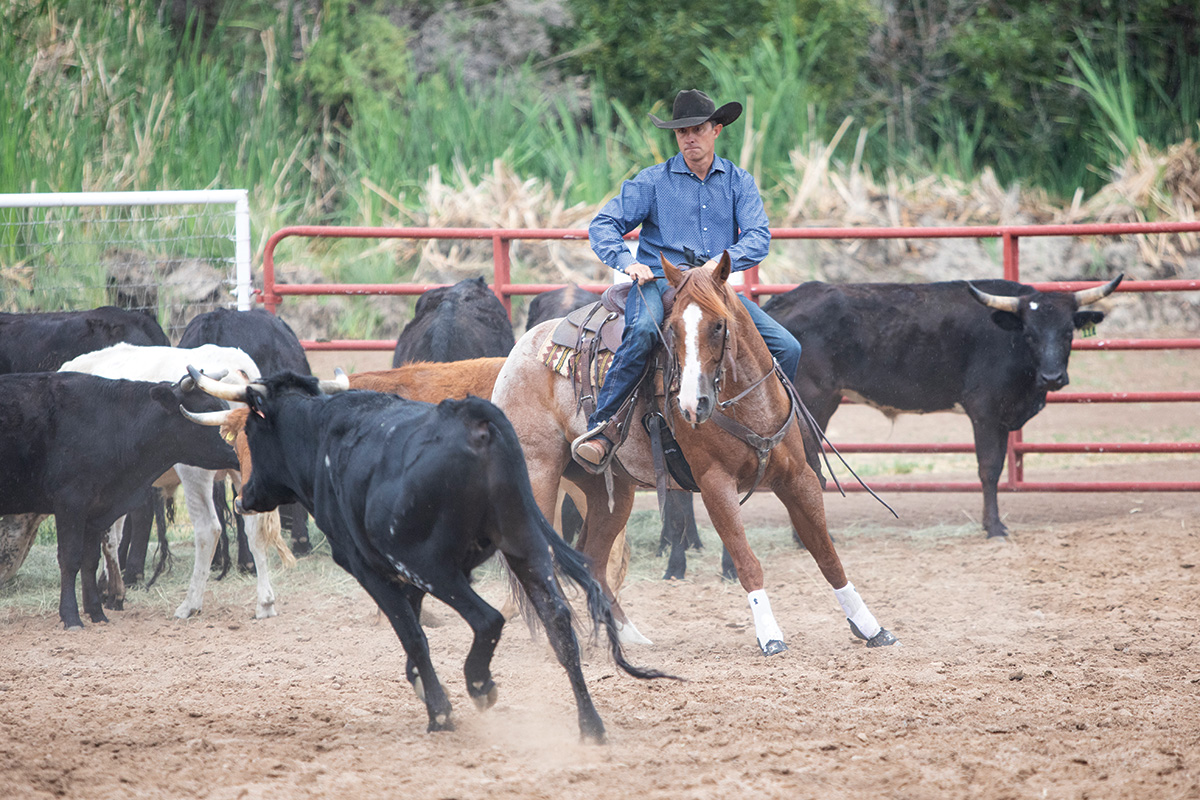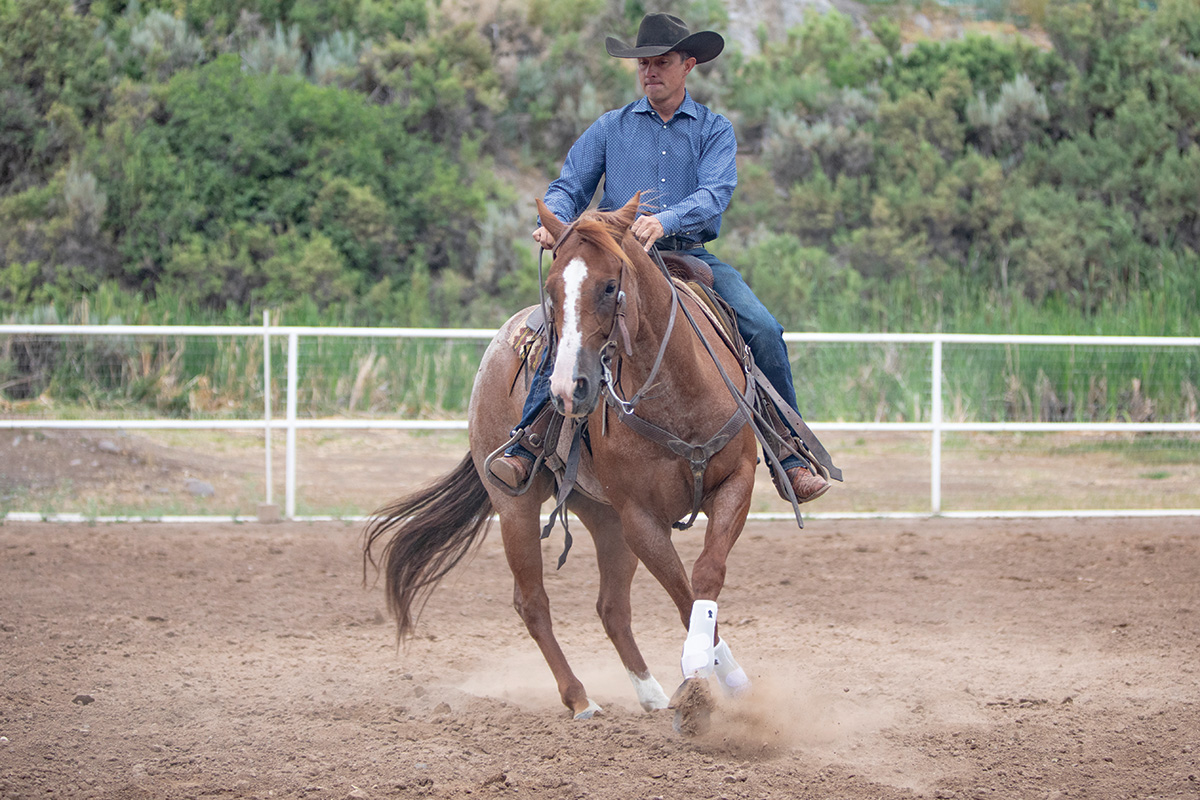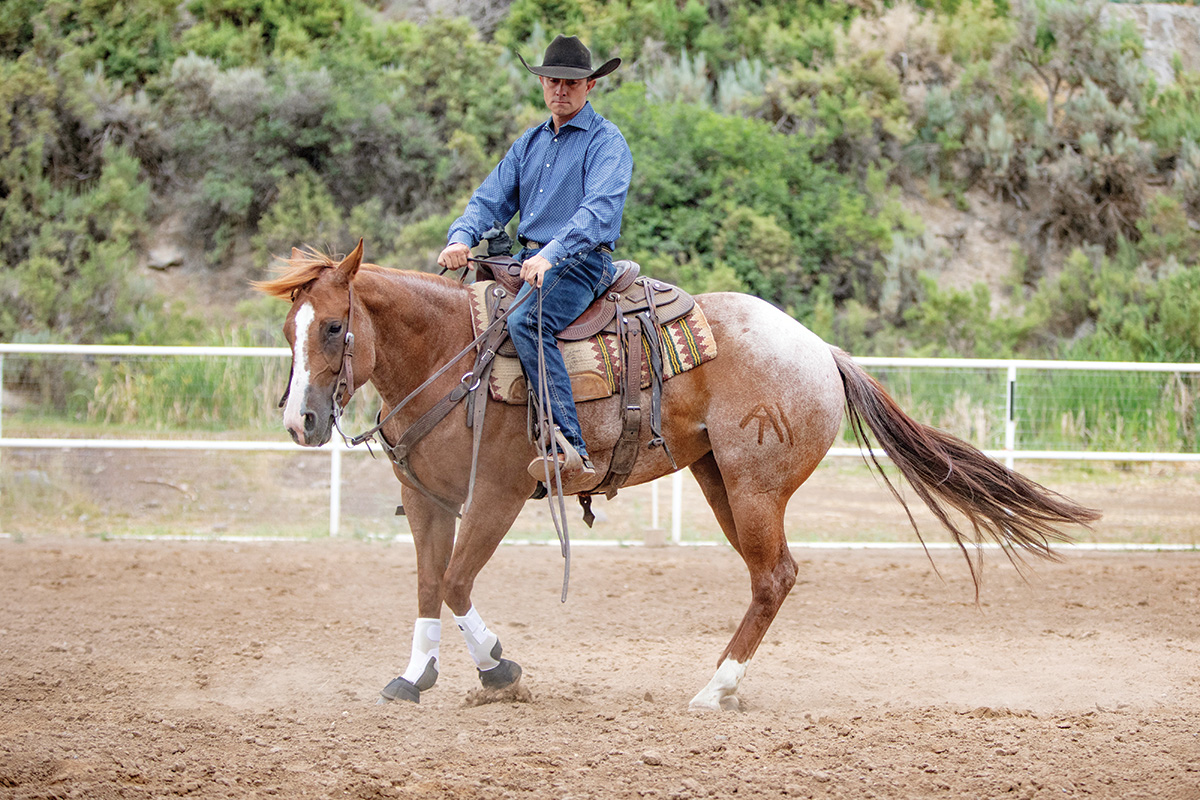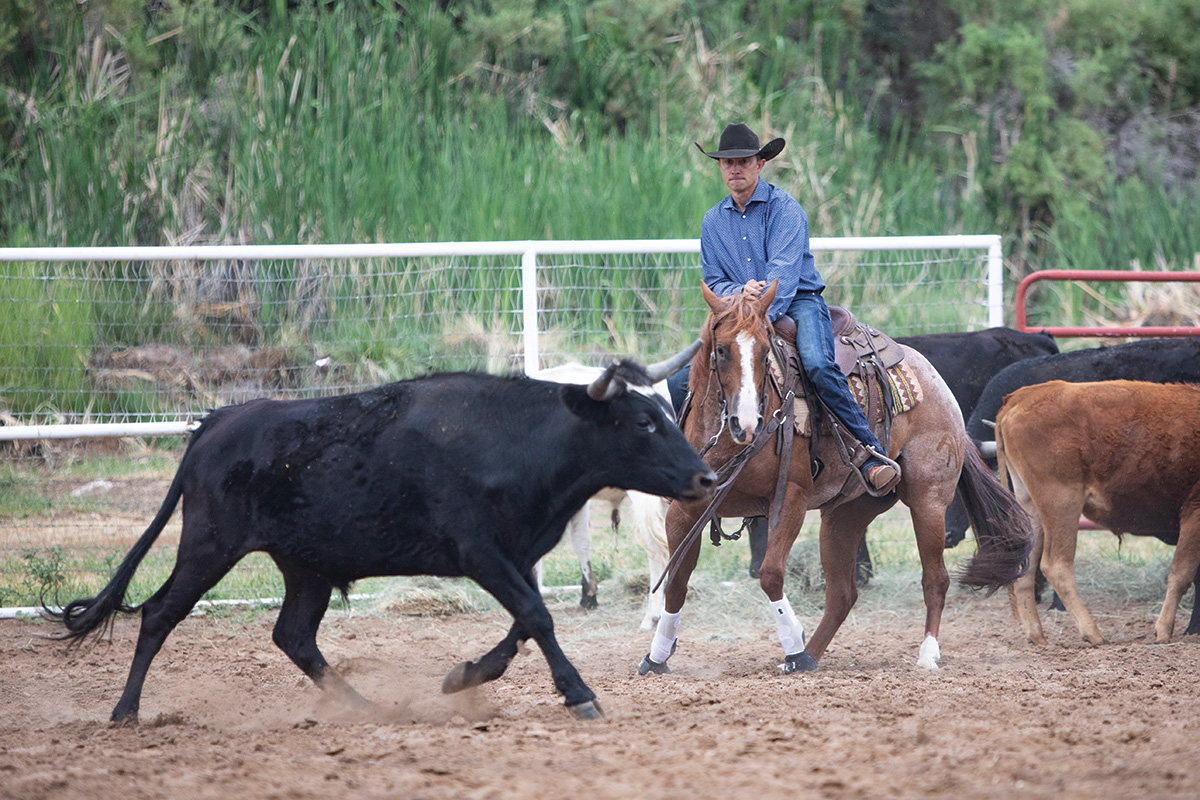
To compete in reining or working cow horse competitions, your horse will need to turn quickly in response to your cues. In reining, the move is a “turnaround,” or spin—the horse moves forward around a pivot foot and continues the move until directed to stop.
Trainer Aaron Ralston explains that all moves for reining or working cow horse events mirror—or were inspired by—horses on cattle ranches.
“Historically, riders wanted to show off their best-trained, most obedient horses,” he says. “While there’s little structure to working cattle in a natural environment, training your horse to do complex maneuvers shows skill and athleticism. The reining turnaround became that signature move that could be judged on a point system. Then when working cattle, your horse needs to be ready to turn sharply in any direction and to change directions often.”
A reining turn forces the horse’s weight to the inside.
“If the horse needed to stop and change directions quickly, he’d have to take a shuffle step before being able to leave in a new direction,” Ralston continues. “The ‘cow turn’ allows him to shift his weight back so that he can change directions without shuffling or regaining balance.”
Use the Clock
Horses should turn precisely—no matter which type of turn is requested. Ralston says he’s often asked about how to cue for the different turns needed in reining and cow horse events.
To explain how to cue for each turn, he teaches riders to envision a clock face over the top of the horse. Everything straight in front of you and the horse’s poll is 12 o’clock. Straight behind you toward the tail is 6 o’clock. Three and 9 o’clock are positioned at your right and left legs. Knowing these positions will help you know where to move your feet, rein and chin positions to cue for the different turns.
Reining Turns

In reining, you want forward motion into the turn. The outside foot is to cross over the inside front foot. The inside hind leg is the predominant pivot foot that bears most of the weight. The outside hind foot helps the horse balance and propels him around.
When being judged, the inside hind foot can move within a small area, but you don’t want that leg to displace into a new area. If the foot stays in the same area throughout the turn, you won’t incur a deduction.
The inside hind hoof moves underneath the center of the horse, right below the rider. That’s the pivot point. The more the horse contracts together over the pivot point, the faster he can move.

Imagine a figure skater who spins faster when pulling her arms into her center. The horse will also spin most quickly when his body is tucked and his pivot hoof reaches far under his body.
When you’re ready to start the reining turn to the right, you want your horse’s inside front hoof to step to 3 o’clock continuously to produce the balance point for the optimum turn. To achieve this, use three body cues: Move your inside foot off the horse and point it to 3 o’clock while your outside leg supports the horse without constant cueing.
Lastly, move your chin to 3 o’clock. When you move your chin, other body cues (including your shoulders and hips) naturally follow. Riding one-handed, move your hand above the saddle horn and toward 3 o’clock.
“I like to sit very neutrally with my shoulder, hip and heel alignment in place,” Ralston says. “The cues with the three body parts will tell the horse the destination I expect.”
Ralston says he makes sure to cue the horse once and expect perpetual motion. He doesn’t want to constantly kick the horse, but to teach the horse to keep going until he cues for something different.
If the horse needs encouragement, he will use his outside leg until the horse returns to the speed he wants. He says that if he always pushes with his outside leg, he finds that horses hunt for a change in leg pressure so that they can be done.
“If I’m always pushing with my outside leg, then he’s thinking, ‘When does that outside leg come off, when do I get to quit?’” Ralston says. “That creates a horse that takes smaller steps and is waiting to be done.”
When it’s time to stop the turn, take both legs off the horse and shift your weight to your legs. Return your reining hand to the middle of the horse’s neck and say “whoa.”
Working Cow Horse Turns
“A horse needs to be able to turn in any manner necessary that affects a cow’s flight zone in relation to the destination you want the cow to go,” Ralston says. “Typically, you won’t be making a cow go somewhere. Instead, you shut the door on all the options and open the door to the direction you’d like her to go. It’s pressure and release. The cow releases herself from the pressure the horse puts on and goes where she feels free.”

Ralston says if a cow goes somewhere, she’s going to look there before she takes a step. If you want a cow to go straight ahead but she looks to the right, you need to be able to get to the right side of the cow’s vision to block that move.
If a cow is looking at you and wanting to move toward you, you won’t want to do a reining turn. That type of turn with a forward swing would get into the cow’s flight zone and chase her around you. Instead, you’ll turn the hands of the clock past 3 o’clock, shifting your horse’s weight back.
To initiate the cow turn, move your foot, chin, and hands to 5 o’clock. When the horse’s front hoof turns to that increased turn directive, he has to shift his weight backward. The inside hind foot becomes the pivot foot. With the horse’s weight shifted back, you’ll be ready to go wherever you need to work the cow. The horse will be ready to drive off or turn.
“You could compare this movement in the horse to an athlete,” Ralston says. “Think of a basketball player or volleyball player with a wide stance, ready to move in any direction at any moment, depending on where the ball goes. In this position, you’re always ready.”
Will you ever use a reining turn while working a cow? Ralston says he uses the initial cue of the turn (without the constant spinning) when he wants to send a cow away from him in a defensive move. Once the cow is moving away, he’ll most likely cue the cow turn in the next move.
Meet Aaron Ralston: Reining and Cow Horse TrainerTrainer Aaron Ralston works his horses on his family’s Collbran, Colo., cattle ranch and prepares them for world-class competition. He won Top 10 honors at the 2021 AQHA Versatility Ranch Horse World Show riding Blue Tucka Jo in Open Junior Ranch Trail and overall championship finals. Ralston also has championship titles in reining, cutting, working cow horse, and calf roping and earned gold for the United States reining team at the FEI World Equestrian Games. |
This article about turns in reining and working cow horse events appeared in the October 2022 issue of Horse Illustrated magazine. Click here to subscribe!





